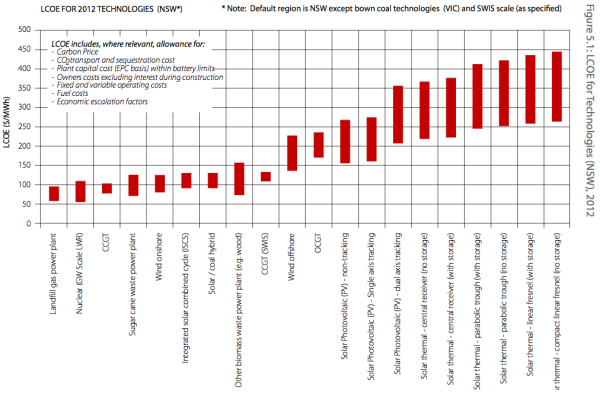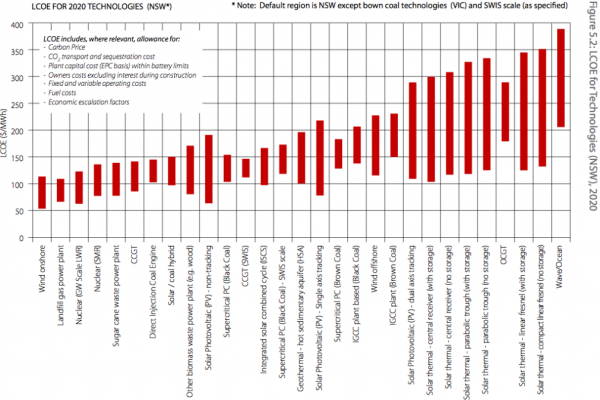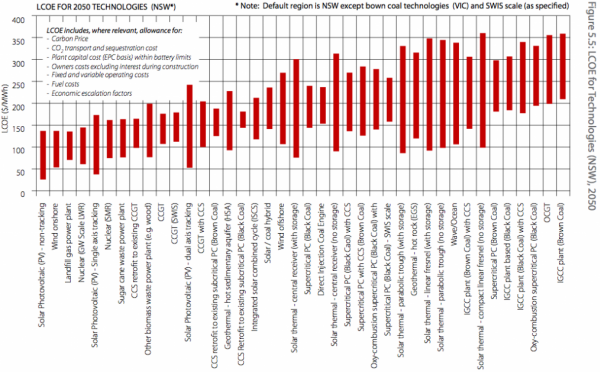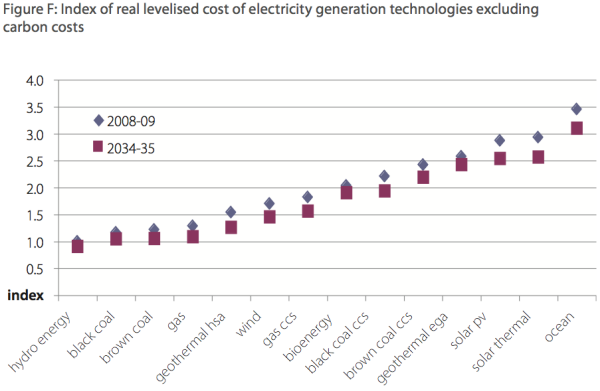The Australian government’s chief energy forecasting body has published a dramatic revision of its cost estimates, predicting that onshore wind and solar PV will deliver the cheapest forms of energy by 2030 — with solar PV dramatically cheaper than all other energy forms by 2050.
The Australian Energy Technology Assessment (AETA) prepared by the government’s Bureau of Resources and Energy Economics (BREE) slashes its previous estimates of the cost of a whole range of renewables technologies, and in some cases doubles the predicted cost of coal-fired generation in the decades to come — with or without the addition of carbon capture and storage.
Its estimates of the cost of gas generation are relatively unchanged, around $130/MWh, but in its most controversial conclusion is says that nuclear energy currently represents the cheapest form of energy — saying that its range of costs is between $55 and $100/MWh, even though the experience in the UK is that new nuclear requires tariffs of at least $220/MW to get built.
BREE’s Professor Quentin Grafton said in the report, prepared in conjunction with engineering group WorleyParsons, that by 2030 some renewable technologies, such as solar PV and wind, are expected to have the lowest LCOE of all of the evaluated technologies.
“The results indicate that Australia’s energy future is likely to be very different to the present,” the report concludes. “This has profound implications for electricity networks, how energy is distributed and Australia’s ability to meet its targeted greenhouse gas emissions reductions.”
These are the first government-sponsored technology cost estimates published since the draft Energy white paper was released last December. That paper virtually ignored solar as a contributing element to Australia’s energy grid, but it now recognises that estimates for solar PV were wide of the mark, and its costs have fallen dramatically and would continue to do so (even though the report predicts no cost declines between 2020 and 2030).
The estimates for 2012, 2020, 2030 and 2050 are published below. The contrast with the December predictions — published at the bottom — is informative.
BREE suggests that solar PV will be competing with onshore wind, biomass and, controversially, nuclear in Australia by the end of the decade, before emerging as the cheapest technology in subsequent years. Its estimates are for a midpoint of around $224/MW now, around $116/MWh by 2030 and a midpoint of $86/MWh by 2050, and as cheap as $70/MWh by 2020 and $30/MWh by 2050. Even brown coal, without a carbon price and CCS, is costed at around $100/MWh by 2020, nearly double that with a carbon price, and with CCS is costed between $150/MWh and $200/MWh, depending on the technology.
Its predictions for other renewable technologies may also be disputed by some technology developers.
A range of solar thermal technologies are appraised, with current costs estimated at more than $300/MWh, falling to around $200/MWh by 2025, but then making no further progress. Solar thermal developers, along with the International Energy Agency, believe costs will fall to around $100/MWh by the end of the decade. An Australian industry report released in June suggested costs of $120-$130/MWh could be reached.
The AETA report sees the average cost of onshore wind at $116/MW (although some are being built now in Australia for around $80/MW), and while it sees this falling to the low $90s/MW by 2025, it then predicts a gradual rise in costs, which may be disputed by the industry. It says offshore wind would cost around $194/MW now, and be virtually unchanged out to 2050.
In wave power, where Australian developers predict costs coming down to around $100/MWh by the end of the decade, BREE suggests it will still cost around $222/MW by 2025, but then achieve no further cost reductions over the next 25 years.
Geothermal (hot rocks) is expected to deliver costs of around $215/MWh in 2025, and then gradually increase in costs to $222/MWh, while hot sedimentary aquifer’s will cost around $154/MWh from around 2020 and also increase in costs. Geothermal developers have previously predicted costs of around $100/MWh, although they have gone a bit quiet on these predictions recently due to a lack of progress.
Among the non-renewable technologies, BREE said combined cycle gas (and in later years combined with carbon capture and storage) and nuclear power offered the lowest LCOE over most of the projection period, and they remain cost competitive with the lower cost renewable technologies out to 2050.
However, its forecasts for nuclear are astonishing, given the experience in the UK, which already has nuclear plants and is desperate to build more. The BREE report suggests the cost for new-build nuclear in 2012 in Australia would be less than $100/MWh, rising slightly to around $126/MWh in 2050. Last week, the Financial Times reported that French nuclear giant EDF is asking for £165/MWh — or $250/MWh — to build the Hinkley Point project, and a French government committee estimated the ongoing costs of nuclear plants already built would be around $88/MW by 2017, and that does not include the capital costs. The BREE report says decommissioning costs were not factored in to its calculations.













“nuclear energy currently represents the cheapest form of energy — saying that its range of costs is between $55 and $100/MWh, even though the experience in the UK is that new nuclear requires tariffs of at least $220/MW to get built.”
This is essentially a function of private sector investment time horizons being too short.
The South Koreans are building 4x1400MW nuclear plants in the UAE, expected to be complete by 2020.
http://www.world-nuclear.org/info/UAE_nuclear_power_inf123.html
The total earnings to the KEPCO is estimated at $40 billion, half to build and half to jointly run for 60 years … lets add $20 billion for the UAE joint operations bill.
What’s that in dollars per megawatt hour? By my calculations with a 90% capacity factor (which the South Koreans are exceeding) this is about $22/MWh
Have I missed anything?
Bizarre that they feel free to clain that nuclear is the cheapest when decommissioning costs were not factored in to the calculations. I am sure that they didn’t factor in the cost to taxpayers if it blows up either, which is now estimated at hundreds of billions for Fukushima. You’d get a lot of renewable energy for that money, not to mention the thousands of square km of prime agricultural and urban land that become uninhabitable in the event of a disaster.
‘decommissioning costs not included’ is disputed, see comments at reneweconomy.com.au/2012/canberra-concedes-wind-solar-to-be-cheapest-energy-by-2030-82930. The LCOE figures given are similar to those in a 2010 report by the IEA, which definitely do incorporate decommissioning costs.
Well this is what we want – renewable energy prospering because it is competitive in its own right, not because it is being pushed on us by eco-fascists with an anti-growth agenda. I hope the publishers of the report are not eco-fascists.